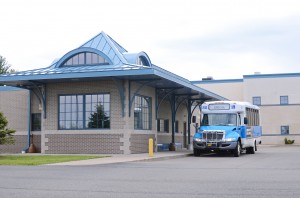It’s a blustery Marquette afternoon, and NMU student Michael Williams, a junior environmental science major, waits for a bus on the corner of Presque Isle Avenue and Union Street.
 Williams’ intended destination is Econo Foods, where he will shop for his standard two week supply of groceries, but he first must catch a bus interchange Marq-Tran’s newly built transfer station in downtown Marquette.
Williams’ intended destination is Econo Foods, where he will shop for his standard two week supply of groceries, but he first must catch a bus interchange Marq-Tran’s newly built transfer station in downtown Marquette.
Although he has a working car, Williams chooses to take advantage of Marq-Tran’s zero-fare student services for a variety of reasons. According to Williams, perhaps the most important reason is how expensive gas has become in recent weeks.
According to the American Automobile Association of Michigan, gas prices in Marquette jumped 15 cents during the past month, raising the area average to $4.02 per gallon.
“I think the rational response to rising gas prices is to take public transportation,” Williams said. “I have a car, but gas prices totally affect whether or not I use it. I usually either opt for walking or for taking the bus.”
Williams said taking advantage of free public transportation is a great way to avoid “using the car as a personal wheelchair.” Williams said he thinks students, including himself, rely too much on their own vehicles when they could be carpooling or riding the bus, adding that he would like to see more cash-strapped students taking advantage of Marq-Tran’s zero-fare student transport, which allows any NMU student to ride for free.
“A lot of students don’t even know they have free access,” Williams said. “I would like to see Northern plug it more and tell students ‘Hey, you have free transportation.’ I didn’t hear it directly from Northern; I heard it through the grapevine. Maybe it’s just that I don’t pay attention, but a lot of students don’t either.”
According to stats provided by Niki Norman, principal secretary at Public Safety, ridership for both on- and off-campus bus routes over the past few years has fluctuated greatly.
According to Norman, the off-campus fixed-route ridership from August 2011 to April 2012 was 34,785, while numbers for September 2012 to April 2013 were 39,404, indicating an increase in the use of off-campus transportation. The on campus transportation indicated a different pattern, however.
“For August 2011 through April 2012, the total passengers for Marq-Tran’s on-campus routes was 50,023,” Norman said. “The on-campus statistics are not complete, but ridership from August 2012 to March 2013 has been 33,671.”
However, because the on-campus Wildcat Shuttles only transport students during the academic year (fall through spring semester), Public Safety’s statistics concerning on-campus ridership in 2013 are not yet complete.
Still, Norman said the 16,352 passenger difference could be easily explained.
“The tentative shuttle numbers for April 2013 are 7,800. They are still compiling the numbers from this week,” she wrote. “That would bring the ridership for 2012-13 to approximately 41,471.”
Norman said both inclement weather and absence of classes in observance of Martin Luther King Day could have also affected this number.
And while the off-campus ridership statistics indicate an increase in people utilizing public transportation, a 2013 study by Smart Growth America revealed that less than one percent of Marquette workers 16 and older said they commuted by public transportation between 2009 and 2011.
The overwhelming majority of workers chose to drive their own cars instead, even when Marquette saw its highest ever recorded gas price — $4.30 per gallon — in May 2011. In fact, according to the study, more workers chose to walk instead of riding the bus. Some students seem to share a similar outlook on public transportation.
“My job requires me to have a car and drive it around anyway,” said Joe Jacisin, a junior NMU student studying heating, ventilation and air conditioning systems. “I’m a pizza guy, so I just use my car because it’s required for work. Plus, I feel more comfortable driving in my own car.”
As a pizza deliveryman, Jacisin said his gas is typically paid for by tip money. Although he almost never rides the bus, Jacisin did admit he would take full advantage of Marq-Tran’s services if he found himself out of work or without a car.
“This town is small enough to where public transportation works efficiently,” Jacisin said. “The buses are always running all over Marquette and it seems like it never takes very long to get from one place to another. I don’t take the bus personally, but I’m glad the option is there.”
Marq-Tran is Marquette County’s only public transportation authority. It was established in 1970 and operates daily in Marquette, Ishpeming and Negaunee, as well as in an array of other local townships.
According to Smart Growth America, Marq-Tran receives funds through the Michigan Department of Transportation from the Federal Transit Administration’s Section 5311 program, which provides funding to non-urban areas with populations fewer than 50,000. The transit authority also receives funding through a county-wide property tax, according to the same organization.
Studies conducted by AAA Michigan suggest gas prices statewide have been consistently higher than the national average for the past 12 months.
Currently, the statewide average is $4.09 per gallon of regular unleaded gasoline. The current nationwide average is $3.62.























